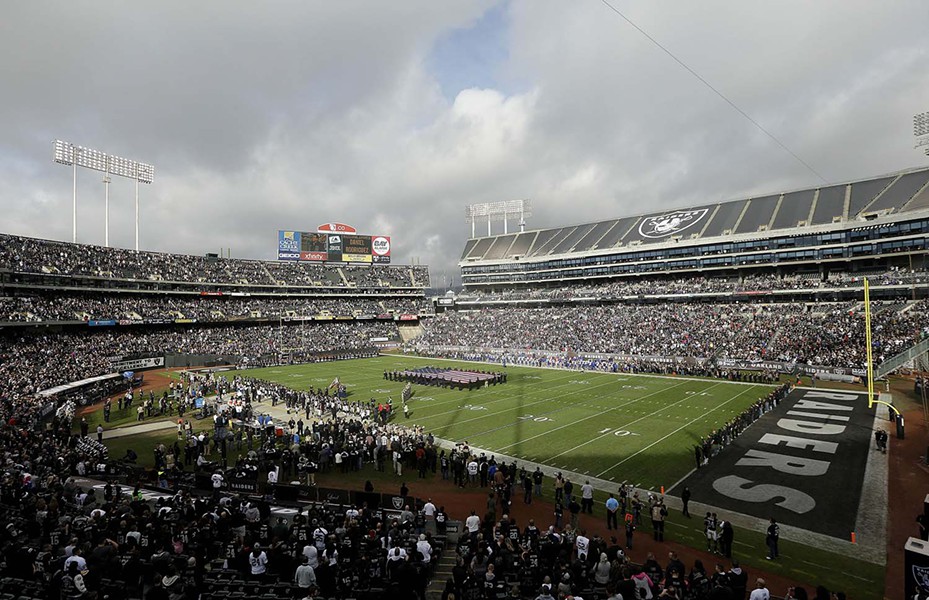Originally published by The San Francisco Examiner.
If the Raiders leave the Bay Area and return to Los Angeles — now more a likelihood than an idle threat — the seeds may be planted this week about 15 miles from O.co Coliseum in a San Francisco hotel.
Raiders owner Mark Davis will communicate the lack of local progress on a new stadium at the NFL’s spring owners’ meetings, with commissioner Roger Goodell committed to gathering answers and moving forward in hopes of placing one or two franchises in the nation’s second-largest market.
Any chance of remaining in Oakland, where the 48-year-old Coliseum is outmoded in a stadium era of money-making colossuses, depends on a far-flung financing plan by San Diego real-estate mogul Floyd Kephart. But rather than demand Kephart’s Coliseum City master plan be ready for the owners’ meetings, Oakland city officials agreed to grant him a timetable next month. Given the fast track for a $1.7-billion combined Raiders-San Diego Chargers stadium in the L.A. suburb of Carson — and the option of joining a rival stadium project in Inglewood financed by St. Louis Rams owner Stan Kroenke — the lag time seems to symbolize the impending doom.
The Raiders have nowhere to go but south, where they played between 1982 and 1994 and won their third and last Super Bowl. If they leave, it increases chances that the A’s, after futile attempts by owner Lew Wolff to find a new stadium site in San Jose and elsewhere, of staying where they are in a new or renovated baseball-only park.
“[Kephart] is under a set of commitments by June 21 on a number of key pieces of information and analysis. That will then enable the city council [whether] to move forward with a real deal with him — and the Raiders and the A’s,” Oakland city administrator Claudia Cappio said.
The NFL is not impressed. The league official supervising the Los Angeles undertaking, Executive Vice President Eric Grubman, expressed little enthusiasm after a recent Oakland visit. Local officials sense what’s coming.
“It’s somewhat appalling to me that the NFL wants to abandon the city of Oakland,” Alameda County supervisor Scott Haggerty said. “They have a great opportunity to be a part of the rebirth of Oakland by not only building a stadium, but being part of building a new community.”
Cappio is working with the mayor’s office and Alameda County officials to assemble a proposal that rivals the much-ballyhooed Carson plan. But the reality is this: Even if Davis and the NFL come up with a half-billion dollars, the rest of the money, for a stadium that will cost no less than $1 billion, won’t be there unless Kephart’s plan is legitimate. Grubman says the San Francisco meetings will be important in the process. He and Goodell will hear from the teams potentially moving to L.A. — Raiders, Chargers and Rams — and will weigh progress reports in their current cities.
The San Diego mayor has pledged to keep the Chargers, but no serious movement has been made on a new stadium. St. Louis is expected to have a public vote on a new stadium, though it might not be enough to keep Kroenke and the Rams in town.
Oakland? Other than a skeleton plan for Coliseum City — a multibillion-dollar, multisport downtown revitalization effort — nothing’s happening. Carson officials are driving the pace car in this race.
“There’s a lot of buzz and static right now, and what we’re trying to do is stay on a steady course and be practical,” Cappio said. “And Coliseum City is great because we own it. It’s obviously ripe for redevelopment, and BART is set to do some extensive improvements to that station and some developments around there have been pretty exciting.”
The original plan for Coliseum City included 100-percent private funding and was to be structured around personal seat licenses. Oakland officials have said profits would come from surrounding homes and business, but the NFL opposes this.
“Oakland has supported the NFL and the Raiders for many years, providing a fan base that is second to none,” Haggerty said. “So I think it’s truly unfortunate that the NFL wants to move such a historic franchise out of a culturally diverse community such as Oakland.”
Today’s NFL, a $12-billion-a-year industry, isn’t about tradition. It’s about dollars and cents. All that’s left now, it seems, is the cavalcade of moving vans.
